Buy IGNOU PGDUPDL Project for MEDSP 45
The IGNOU Post Graduate Diploma in Urban Planning and Development (PGDUPDL) has a project component, MEDSP 45 that allows students to apply theoretical knowledge to real-world urban planning difficulties. This project is an essential component of the degree, requiring students to perform independent study on themes concerning urban planning, governance, development, or sustainability.
The major goal of the IGNOU PGDUPDL Project is to assist students in developing practical abilities in urban problem analysis, innovative solution proposal, and actionable plan development. It usually entails identifying a specific urban issue, developing research questions, doing fieldwork, and putting the results into a well-structured report.
Students can select topics including urban housing, infrastructure development, waste management, urban transportation, or the impact of urban policies on marginalized people. The project necessitates thorough research, which includes data gathering (both quantitative and qualitative), literature evaluation, and analysis. Students are additionally guided by an academic supervisor appointed by IGNOU.
Whatsapp us to get the Personalized (Customized) IGNOU PGDUPDL Project Report and Synopsis
Download PDF Link for IGNOU PGDUPDL Project (MEDSP 45)
Steps to Complete the PGDUPDL Project
1. Choose a Relevant Topic
Pick a topic that aligns with urban development challenges and resonates with your interests or local context.
2. Prepare a Project Synopsis
The synopsis is the foundation of your project. Include these sections:
- Title: A clear and descriptive title.
- Introduction: Briefly explain the problem and its significance.
- Objectives: Define the goals of your study.
- Research Questions: Frame questions your research seeks to answer.
- Methodology: Describe the approach you will take, including data collection methods.
- Scope and Limitations: Outline the boundaries and constraints of your research.
- Expected Outcomes: Highlight the intended results and their impact.
- References: List preliminary sources for your research.
3. Conduct Research
To acquire data, conduct field surveys, interviews, or case studies. You may also use current urban development papers or government publications.
4. Write the Project Report
Structure your report as follows:
- Title Page: Include your project title, name, enrollment number, and course code.
- Acknowledgment: Thank contributors and mentors.
- Abstract: Provide a concise 200–300-word summary of your project.
- Introduction: Explain the problem, objectives, and importance of the study.
- Literature Review: Discuss related studies and identify gaps your project addresses.
- Methodology: Detail your research design, tools, and techniques.
- Findings and Analysis: Present data and discuss insights.
- Conclusion and Recommendations: Summarize findings and propose solutions.
- References: Cite all sources.
- Annexures: Add supplementary materials like questionnaires, maps, or raw data.
Sample of IGNOU PGDUPDL Project topics for MEDSP 45
- A STUDY ON ENVIRONMENT DEGRADATION/POLLUTION ETC IN YOUR CITY
- A STUDY ON MICRO FINANCE FACILITIES AND ANALYZING THE AWARENESS LEVEL OF PEOPLE ABOUY MICRO FINANCE IN YOUR CITY
- A STUDY ON MID-DAY MEAL MANAGEMENT IN YOUR CITY
- A STUDY ON CULTURE OF YOUR CITY/STATE
- RELATIONSHIP BETWEEN THE DECISION MAKING PATTERN OF URBAN WORKING AND NON-WORKING WOMEN WITH RESPECT TO THEIR HOME ACTIVITIES
Who is eligible to serve as the Guide/Supervisor for the IGNOU PGDUPDL Synopsis and Project Report?
The learner will therefore necessitate a Guide/Supervisor to execute the Project.
Accordingly, the qualifications for eligibility to serve as a Guide/Supervisor are as follows:
- Direct access can be obtained from the Study Centre, Regional Centre, or Maidan Garhi.
- Phil/PhD in Urban Planning and Development with at least two years of undergraduate or postgraduate teaching experience
Alternatively,
- Master’s Degree in Urban Planning and Development with a minimum of two years of postgraduate experience.
- A Master’s Degree in Urban Planning and Development accompanied by a minimum of five years of undergraduate teaching experience.
How does the IGNOU PGDUPDL Project contribute to practical urban planning skills?
The IGNOU PGDUPDL Project plays a crucial role in developing practical urban planning skills by bridging theoretical knowledge with real-world applications. Here’s how it contributes:
- Problem Identification and Analysis: Students learn to identify urban issues, such as housing shortages, traffic congestion, or waste management, and analyze their root causes. This enhances critical thinking and problem-solving skills.
- Research Methodology Application: The project requires students to employ various research methodologies, including surveys, case studies, and fieldwork, to collect and analyze data. This provides hands-on experience in data-driven decision-making.
- Policy and Solution Development: Students gain the ability to propose actionable solutions and policies to address urban challenges, fostering creativity and innovation.
- Fieldwork and Stakeholder Engagement: By interacting with urban communities, government officials, or private entities, students develop skills in stakeholder communication and collaboration.
- Urban Planning Tools: Exposure to tools like GIS (Geographical Information Systems) or statistical software equips students with technical competencies essential for urban planning.
- Report Writing and Presentation: Compiling findings into a structured report improves academic writing, while presenting results hones communication skills.
How can students effectively integrate case studies into their IGNOU PGDUPDL Project?
Integrating case studies into the IGNOU PGDUPDL Project can add depth and practical relevance to the research. Here are steps students can follow to effectively incorporate case studies:
1. Choose Relevant Case Studies
- Select case studies that directly relate to your project topic and objectives. These can be local or global examples addressing similar urban planning issues, such as housing, transportation, or environmental sustainability.
2. Align with Research Objectives
- Ensure the case studies support your research objectives by providing insights, comparisons, or evidence to validate your findings.
3. Collect Comprehensive Data
- Gather detailed information on the case studies from reliable sources like government reports, academic papers, urban planning organizations, or direct fieldwork.
4. Highlight Key Features
- Focus on aspects like the problem addressed, strategies implemented, challenges faced, and outcomes achieved in the case study. Clearly show how these elements relate to your research.
5. Use Visuals and Data
- Include visuals like maps, graphs, or photographs to make the case studies engaging and easier to understand.
- Present relevant quantitative or qualitative data to support your analysis.
6. Draw Comparisons
- Compare the case studies with your project context, identifying similarities, differences, and lessons learned.
7. Analyze Outcomes
- Critically analyze the success or limitations of the case studies and discuss how these findings can inform your recommendations.
8. Integrate Smoothly
- Integrate case studies into the main body of your report, either within the analysis or as standalone sections, depending on their relevance.
How can students choose a relevant local or global issue for the IGNOU PGDUPDL Project?
Choosing a relevant local or global issue for the IGNOU PGDUPDL Project involves careful consideration of various factors to ensure the topic is meaningful, feasible, and aligned with urban planning objectives. Here’s how students can make the right choice:
- Assess Personal Interest and Expertise: Select a topic that aligns with your interests and strengths. A genuine passion for the subject will motivate you throughout the project.
- Understand Local and Global Relevance: Analyze pressing urban issues in your area, such as housing shortages, traffic management, or waste disposal. Alternatively, explore global concerns like climate change, sustainable urbanization, or smart cities.
- Align with Urban Planning Themes: Ensure the issue falls within core urban planning themes, such as land use, infrastructure development, environmental sustainability, or community participation.
- Review Existing Literature: Conduct a preliminary review of academic articles, reports, and case studies to identify gaps or areas needing further exploration.
- Consider Feasibility: Evaluate the availability of data, resources, and time required to address the issue effectively. Choose a manageable topic within the scope of the MEDSP 45 project.
- Consult Academic Supervisors: Seek guidance from IGNOU-assigned supervisors to validate your topic’s relevance and scope.
- Focus on Impactful Solutions: Prioritize issues where your research can contribute practical, actionable solutions to benefit local communities or global urban policies.
What strategies can students use to meet deadlines for the IGNOU PGDUPDL Project?
Meeting deadlines for the IGNOU PGDUPDL Project requires strategic planning and disciplined execution. Here are some effective strategies students can adopt:
1. Understand the Timeline
- Review the IGNOU guidelines and deadlines for proposal submission, approval, and final report submission.
- Create a project calendar with clear milestones for each phase, such as topic selection, research, data collection, analysis, and report writing.
2. Start Early
- Begin the project as soon as possible to allow ample time for revisions, supervisor feedback, and unforeseen challenges.
3. Break the Project into Phases
- Divide the project into smaller tasks, such as literature review, methodology design, fieldwork, and report writing.
- Assign deadlines to each phase to track progress.
4. Set Daily and Weekly Goals
- Establish specific, achievable goals for each day or week, such as completing a section of the literature review or collecting data from a specific location.
5. Maintain Regular Communication with Supervisors
- Schedule regular meetings with your supervisor to seek feedback and ensure you’re on track.
- Address any concerns or bottlenecks early to avoid delays.
6. Prioritize Tasks
- Focus on high-priority tasks first, such as data collection and analysis, which are time-intensive and critical to the project.
7. Use Productivity Tools
- Utilize tools like Gantt charts, task management apps (e.g., Trello, Asana), or spreadsheets to organize and monitor your tasks.
8. Allocate Time for Revisions
- Reserve time at the end for proofreading, formatting, and incorporating supervisor feedback into the final report.
9. Minimize Procrastination
- Work consistently on the project instead of leaving major tasks for the last minute.
10. Avoid Perfectionism
- Focus on completing each phase effectively rather than striving for perfection in every detail.
What are the common mistakes students should avoid while preparing the IGNOU PGDUPDL Project?
Students should be mindful of common mistakes that could affect the quality and evaluation of their IGNOU PGDUPDL Project. Here are some key pitfalls to avoid:
1. Inadequate Topic Selection
Choosing a vague or irrelevant topic can misalign the project with the course objectives. Ensure the topic addresses a specific urban development issue.
2. Poor Research Proposal
Submitting an incomplete or unclear proposal may result in delays or rejections. Follow IGNOU’s guidelines closely and seek supervisor feedback before submission.
3. Lack of Time Management
Procrastinating or failing to adhere to deadlines can compromise the quality of the work. Plan a timeline and stick to it.
4. Insufficient Literature Review
Skipping a thorough review of previous studies may lead to redundant or poorly informed research. Spend adequate time understanding existing literature.
5. Weak Methodology
Using inappropriate or poorly defined research methods can undermine the validity of your findings. Clearly justify the methods used and align them with your objectives.
6. Inadequate Data Collection
Relying on incomplete, biased, or unverified data can lead to unreliable conclusions. Ensure data is accurate, comprehensive, and sourced ethically.
7. Overlooking Supervisor Feedback
Ignoring suggestions from your academic supervisor can lead to repeated mistakes. Regularly consult and incorporate feedback into your work.
8. Improper Structuring of the Report
Failing to organize the report into clear sections (introduction, methodology, analysis, conclusion, etc.) can make it difficult to follow. Use the recommended IGNOU format.
9. Plagiarism
Copying content without proper citation is a serious academic offense. Use original content and reference all sources accurately.
10. Neglecting Presentation Requirements
Overlooking presentation elements like grammar, formatting, and visuals can affect the overall quality. Proofread thoroughly and use diagrams or maps where applicable.
11. Skipping Final Revisions
Submitting the report without reviewing it for errors or inconsistencies may result in lower grades. Allocate time for proofreading and refining.
Ready to get your IGNOU PGDUPDL Project Report and Synopsis Sample PDF for MEDSP 45?
- Call us or WhatsApp us at: 9958947060, 9354637830
- Visit: SHRICHAKRADHAR.COM
-
Sale!
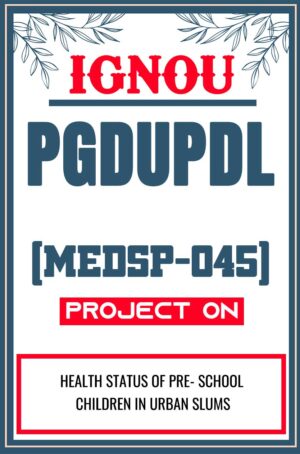
-
Sale!
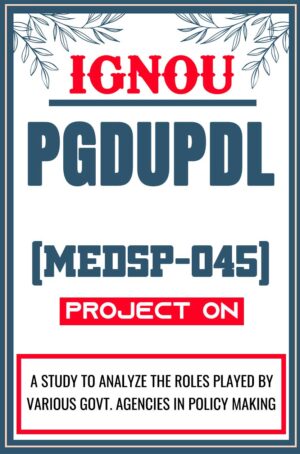
IGNOU PGDUPDL Project (MEDSP-045) Synopsis/Proposal & Project Report/Dissertation in Hard-Copy (Sample-4)
Original price was: ₹499.00.₹249.00Current price is: ₹249.00. -
Sale!
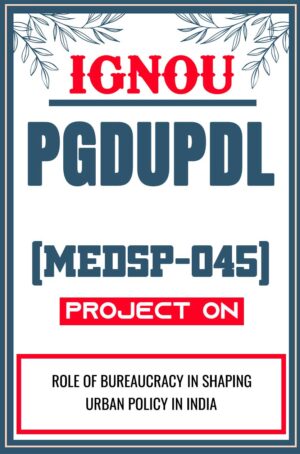
IGNOU PGDUPDL Project (MEDSP-045) Synopsis/Proposal & Project Report/Dissertation in Hard-Copy (Sample-3)
Original price was: ₹499.00.₹249.00Current price is: ₹249.00. -
Sale!
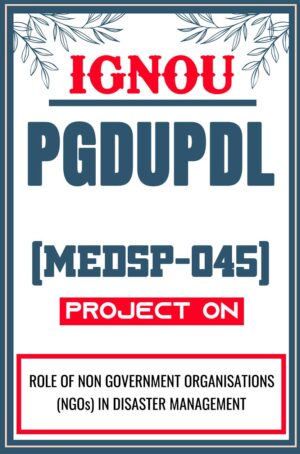
IGNOU PGDUPDL Project (MEDSP-045) Synopsis/Proposal & Project Report/Dissertation in Hard-Copy (Sample-2)
Original price was: ₹499.00.₹249.00Current price is: ₹249.00. -
Sale!
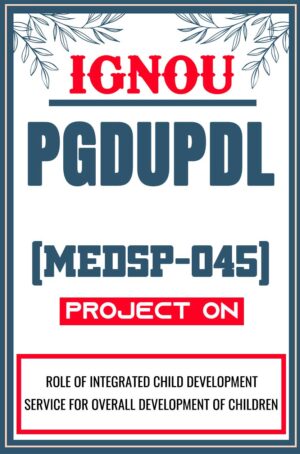
IGNOU PGDUPDL Project (MEDSP-045) Synopsis/Proposal & Project Report/Dissertation in Hard-Copy (Sample-1)
Original price was: ₹499.00.₹249.00Current price is: ₹249.00.
